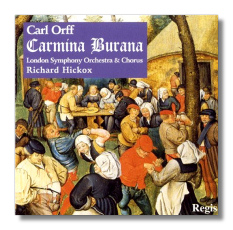
The Internet's Premier Classical Music Source
Related Links
-
Find CDs & Downloads
Amazon - UK - Germany - Canada - France - Japan
ArkivMusic - CD Universe
Find DVDs & Blu-ray
Amazon - UK - Germany - Canada - France - Japan
ArkivMusic-Video Universe
Find Scores & Sheet Music
Sheet Music Plus -
Search Amazon
Recommended Links
Site News
Carl Orff
Carmina Burana

Richard Hickox conducting London Symphony Orchestra & Chorus
Regis RRC1136 -
Cover Notes
Carmina Burana was an instantaneous success at its first performance at Frankfurt am Main n 1937 and for the fifty years since it has never faltered in its standing as one of the most universally popular works produced by a 20th century "contemporary" composer.
Carl Orff (1895-1982), born into an old Bavarian military family, found himself lionised overnight at the age of 42 after years as a teacher of music. Although he was to consolidate his reputation with a wide-ranging canon of music, distinctively unlike anyone else's, over the subsequent forty years, he was never able to escape the cachet of "the Carmina Burana composer".
Orff conceived his "scenic cantata" for the stage. His explicit ambition for it was "total theatre" in which words, music and movement were co-ordinated to create an effect of all-round involvement and it was in the idiom of the theatre that its early performances took place.
Gradually, however, it became the province of purely choral forces and it is in concert performance that the work is familiar nowadays.
For his texts Orff took 25 verses from a collection of 13th century poems discovered in the early 20th century in the abbey of Benediktbeuren near Munich, his native city. Carmina Burana in Latin means Songs of Beuren.
Variously written by itinerant scholars in low Latin and early German, the poems mingle Christian piety and pagan hedonism in a spirit of simplicity and unselfconscious directness which were intrinsic in the medieval approach to mortality. They amount to an uninhibited celebration of the pleasures of life, and, particularly, love. Bed and bawdiness figures strongly in them.
The work is divided into three parts under the titles of "Spring", "In the Tavern" and "Love". The verses themselves are a paeon to the delights those words evoke.
Orff's settings of them throb with a sense of youth and exuberance unshadowed by the sobrieties of moral rectitude or religious moderation. Throughout all his music he made a virtue of simplicity and an incessant rhythmic pulse and stylised configurations of harmonies, structured in massive blocks for large orchestral and choral forces, are the interacting elements which distinguish Carmina Burana. The exhiliration his music generates is that of both the flesh and the spirit.
An exultant chorus in praise of Fortune begins and ends the works, giving voice to the fickleness of fate and fortune and invoking only the most welcome of each to preside over the proceedings.
This theme is carried over into the second poem, expressing the ups and downs of fortune.
No.3 introduces the main consideration of the first section, offering a primal welcome to the arrival of spring.
No. 4 particularises the essence of the season in a baritone solo extolling its life-giving force of love or sex.
No. 5 conversely and setting a wily contrast, depicts how sad springtime can be without the opportunity for love and urges the "have nots" to rectify the matter.
No. 6 is a dance scored with infectious vitality and contrasted in No. 7 by a sporano solo in which a girl laments the loss of her lover.
No 8 brings back the chorus to rejoice in the pleasures of nature and love while No. 9, extending the fervour, inflitrates a winsome invitation to love.
The mood casts off any lurking inhibitions in No. 10 by proposing a lustful fantasy "to hold in my arms the fair Queen of England" (fortuitously unidentifiable thanks to the variable period of the poem's origins!)
No. 11 launches The Tavern section with a predictable salute to the efficacy of the bottle and the flagon and the baritone musing on the personal use he has put them to.
No. 12 brings in the tenor, singing falsetto, with the Song of the Roasting Swan and in No. 13 the baritone takes up the tale of the inveterate gambler.
No. 14 concludes the section with a hymn to the beneficial amenities and well-being of the tavern.
The work's longest section is dedicated, not surprisingly, to Love.
The soprano strikes the keynote in No. 15 with her contention that to be without a lover is rotten luck, the female voices nodding their agreement in chorus.
No. 16 is in the nature of a corresponding cri de coeur from the baritone whose object of desire is indifferent to his suit.
As though taunting him, the soprano returns in No. 17 to fan the libido with a description of a tempting young thing who looks like a rosebud and wears a red skirt.
No. 18 is evocative of the yearning one feels for a lover and, on the assumption that such desires have been fulfilled, No. 19 celebrates the fun to be had in bed, particularly when modern scruples have been flung off with the clothing.
The natural consequence in No. 20 is a fevered exhortation to surrender to the ecstasies of love-making, quickly supplanted in No. 21 by capitulation, tough not before a token moral conflict between chastity and desire has heightened the suspense.
Serving almost as an interlude No. 22 is by way of a recapitulation of all that has gone before…the onset of Spring, the rising of the sap, the boiling over of emotions after the hibernation of winter.













